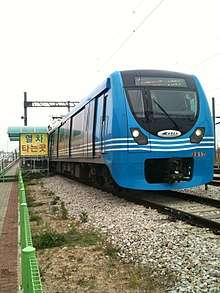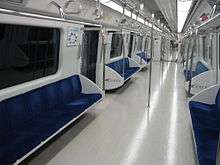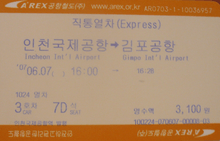AREX
AREX (Airport Railroad Express) is a South Korean commuter rail line that links Incheon International Airport with Seoul Station via Gimpo International Airport. The section between the two airports opened on March 23, 2007, the extension to Seoul Station opened December 29, 2010. Korea Train Express high speed trains started to use the line from June 30, 2014 and discontinued in March 2018 due to low ridership.
| AREX | |
|---|---|
 | |
| Overview | |
| Native name | 인천국제공항철도 (仁川國際空港鐵道) Incheongukjegonghang-cheoldo |
| Type | Rapid transit |
| System | Seoul Metropolitan Subway |
| Status | Operational |
| Termini | Incheon International Airport Terminal 2 station Seoul station |
| Stations | 14 |
| Operation | |
| Opened | Phase 1: 23 March 2007 Phase 2: 29 December 2010 Phase 3: September 2018 |
| Owner | Korea Rail Network Authority |
| Operator(s) | Airport Railroad Corporation[1] |
| Technical | |
| Line length | 63.8 km (39.6 mi)[2][3] |
| Number of tracks | 2 |
| Track gauge | 1,435 mm (4 ft 8 1⁄2 in) |
| Electrification | 25 kV/60 Hz AC catenary |
| Operating speed | 110 km/h (68 mph) |
| AREX | |
| Hangul | |
|---|---|
| Hanja | |
| Revised Romanization | Incheon Gonghang Cheoldo, Eirekseu |
| McCune–Reischauer | Inchŏn gonghang chŏldo, Eireksŭ |
History
Phase 1
The line was initially announced in July 1998 as the Incheon International Airport Railroad (인천국제공항철도), abbreviated IREX (Incheon Airport Railroad Express) which can be seen on the railings of overhead crossings by the line.[4] The project was launched as South Korea's first build-operate-transfer (BOT) franchise.[4] The concession was won by a consortium of 11 Korean companies, which incorporated as the Incheon International Airport Railroad Company (Iiarco) in March 2001.[4] The original main shareholders were Hyundai (27%), POSCO (11.9%), Daelim (10%), Dongbu (10%) and the Korean National Railroad And Ali Aden Mumin(9.9%).[4]
After significant delays, construction of the line started in 2001,[5] after the opening of Incheon Airport. About 60% of the line is underground, and reaches Incheon International Airport on Yeongjong Island via the lower deck of Yeongjong Bridge, a combined road-rail bridge.[4] Iiarco contracted project management, the supply of equipment and trains, altogether worth about €400 million, to Incheon Korean French Consortium (IKFC), a consortium including French company Alstom, its South Korean subsidiary Eukorail, and the South Korean rolling stock manufacturing company Rotem, which also supplied the technology for the KTX high-speed rail system.[4]
The line and the operating company was renamed AREX in June 2006. The first 37.6 km (23.4 mi) segment from Incheon International Airport Terminal 1 to Gimpo International Airport opened on March 23, 2007.[6]
In March 2009, Korail acquired an 88.8% share of the company.[7] Upon the acquisition, the operating company changed its name to Korail Airport Railroad as of November 30, 2009.
Phase 2
Phase 2 of the line runs from Gimpo International Airport to Seoul Station, which increased the length to 58 km (36 mi).[8] At Gimpo the line is underground, rising to the surface to cross the Han River on the Magok Railway Bridge before descending underground for the final time. This section was built in a cut and cover tunnel running parallel to Susaek and Gajwa before connecting with Hongik University and Gongdeok, then diving to terminate deep underground on the west side of Seoul Station. The second phase opened for regular service on December 29, 2010,[9] with the exception of Gongdeok station, which was planned to open around early 2011,[10] but was delayed to November 29, 2011.[11]
Phase 3
Phase 3 of the line was opened in September 2018. During phase 3 Magongnaru station was opened.
Further extensions and improvements

The city of Incheon requested that AREX add three new stations at Cheongna International City, Yeongjong, and Yongyu. The stations were originally planned to open with the second phase of the line, but were delayed due to delays in the real estate development projects the stations were to serve.[12] Cheongna International City station, located west of Geomam was opened on June 21, 2014.[13][14] Yeongjong station, located near the eastern part of the airport island, opened on March 26, 2016. The station was constructed as a station shell with two side platforms only, but underwent a conversion to fit in two outer tracks on each platform to allow for bypass moves.
Earlier plans to link Yongsan station have been dropped. However, KTX service began to run from Yongsan Station to Incheon International Airport on June 30, 2014. These trains stop at two stations along the line: Geomam & Incheon International Airport.[15][16] In March 2018, KTX service to Incheon Airport was suspended due to low ridership.[17] The suspension became permanent in September 2018 as the line was officially abolished.[18][19]
On September 1, 2010, the South Korean government announced a strategic plan to reduce travel times from Seoul to 95% of the country to under 2 hours by 2020. As part of the plan, the AREX line is to be further upgraded to handle 230 km/h (143 mph) speed limits.[20]
Incheon International Airport opened Terminal 2 on January 18, 2018, though the AREX line was extended to the terminal's station 5 days earlier. This brings the whole line to a length of 63.8 km (39.6 mi).[21]
There is currently a proposal for Seoul Subway Line 9 to combine with the AREX line via a direct connection at the Gimpo International Airport Station starting in 2020, providing a through service from Incheon International Airport to the Gangnam area with a travel time of about one hour.[22]
Rolling stock


AREX operates two types of trains, one for commuter and one for express services, both supplied by Hyundai Rotem.[4] Three 1000 series express trains and nine 2000 series commuter trains were delivered for phase 1 of the project,[4][23] and original plans foresaw a doubling of their numbers for the second phase.[4]
Both trains are six-car electric multiple units, which can be expanded to eight cars in the future.[4] End cars and the fourth car are trailers, the second, third and fifth car are powered.[23] The trains have a design speed of 120 km/h (75 mph), but are operated at a maximum 110 km/h (68 mph) on surface tracks and a maximum 100 km/h (62 mph) in tunnels.[23] Each car has a length of 19.95 m (65.5 ft) and a width of 3.12 m (10.2 ft), with a carbody made of aluminum.[4] The commuter version has four pairs of sliding doors on each side of each car, the express version has two pairs of sliding doors on each side of each car.[23]
Express trains have 272 high-back forward and rear-facing seats with armrests[23] in a 2+2 configuration, as well as overhead luggage shelves,[24] additional luggage racks, an onboard restroom, and complimentary WiFi.[25][23] The transition between cars are separated by transparent sliding doors.[23]
Commuter trains are similar to regular metro trains with seats along the walls but do not have overhead shelves.[24] These are open gangway trains, with no separating doors between cars.[23] Commuter trains offer seating for 282 passengers and standing room for 630 passengers.[23]
Both train types offer disabled seats and are equipped with LCD screens for passenger information,[23] including flight arrivals and departures.[24]
Operation
Services
Both Express and commuter "All Stop" services are operated. With the opening of the first phase, journeys from Incheon International Airport to Gimpo International Airport took 28 minutes on express services and 33 minutes on commuter services. Following the opening of the second phase, Seoul–Incheon International Airport travel time on half-hourly Express services is 43 minutes to Terminal 1. The All Stop service, which run at a frequency of up to one train every 6 minutes, take 53 minutes.[10] This compares with an average travel time of 70 minutes on buses and 60 minutes in taxis or private cars.[10]
Express train passengers boarding certain airlines can check in to their flights at the Seoul Station City Airport Terminal on the western side of Seoul Station,[24] which include facilities to check in and x-ray baggage, receive exit stamps from an onsite Korean Immigration Service officer, and permit expedited security screening once at Incheon.[26]
The AREX line is shown on Seoul subway maps as sky blue, often bisected with orange striping. AREX was originally not considered part of the subway network, but following the majority buyout by Korail, who operates many of Seoul's subway lines, the commuter line was fully integrated with the rest of the Seoul Metropolitan Subway system. There are now free transfers for all Seoul and Incheon metro lines it crosses paths with.
KTX
The opening of the second phase in 2010 allowed passengers to connect directly from KTX to AREX services at Seoul Station, rather than requiring a subway connection at Gimpo. In November 2013, the AREX-Gyeongui Line direct connection was completed, and on June 30, 2014, KTX trains started full service on the AREX line to Incheon.[27][28][29][30] The expected travel time at construction was 2 hours 41 minutes to Busan and 3 hours to Gwangju, but as of 2015, actual travel times were roughly 3 hours to Gwangju and slightly over 3.5 to Busan.[31][32]
In late March 2018, KTX service to and from the airport was suspended because of low ridership[33] and the suspension became permanent in September 2018 as the line was officially abolished.[18][19] At the time of the 2018 Winter Olympics, the Korean Ministry of Land, Infrastructure and Transport reported at 15% demand on weekdays.[34]
Fares

After the opening of the first phase, in 2007, a ticket for a ride from Gimpo International Airport to Incheon International Airport cost ₩3,100, both on commuter and express services.[35] This fare increased in steps to ₩3,500 by the end of 2010,[36] then was reduced to ₩3,300 for commuter trains when the second phase opened.[37] The fare for express services, which travel the full Seoul–Incheon International Airport distance non-stop from the opening of the second phase in December 2010, was set at ₩13,300; while the fare for commuter services on the full distance was set at ₩3,700.[10] This competes against a price of around ₩10,000 on buses, ₩67,500 on taxis, and about ₩15,500 with private car.[10]
By 2018, the fares for the full length of the AREX line settled on ₩4,950 for commuter trains,[38] and ₩9,000 for Express service[39] and both require an additional ₩500 deposit if traveling by a single use card.
Ridership
After the opening of the first phase, ridership has been far below expectations. Actual ridership in 2008 was around 16,000 passengers/day, or only around 7% of the forecast 230,000, necessitating subsidies of ₩166 billion.[40] Hyundai had originally forecast ridership of up to 490,000/day when the link to Seoul Station is completed.[40] However, ridership rose significantly after the start of service on the second phase of the line to Seoul Station. As early as the first week, average daily ridership more than doubled, from 27,210 to 58,000.[41]
As of September 2013, the regular train service has approximately 150,000 passengers per day, while the express sees only around 2,000 passengers.[42]
Stations
| Station | Stopping pattern | Connecting services | Distance | Location | ||||||
|---|---|---|---|---|---|---|---|---|---|---|
| # | Name (Hangul, Hanja) |
Commuter 일반 |
Express 직통 |
Station (km) |
Line (km) | |||||
| A01 | Seoul station (서울역, 首尔)[lower-alpha 1] |
◉ | ◉ | - | 0.0 | Yongsan-gu | Seoul | |||
| A02 | Gongdeok (공덕, 孔德) |
◉ | ↕ | 3.3 | 3.3 | Mapo-gu | ||||
| A03 | Hongik Univ. (홍대입구, 弘大入口) |
◉ | 2.8 | 6.1 | ||||||
| A04 | Digital Media City (디지털미디어시티, 数码媒体城)[lower-alpha 1] |
◉ | 3.4 | 9.5 | Eunpyeong-gu | |||||
| A042 | Magongnaru (마곡나루, 麻谷渡口) |
◉ | 8.6 | 18.1 | Gangseo-gu | |||||
| A05 | Gimpo Int'l Airport (김포공항, 金浦空港) |
◉ | Gimpo Goldline Seohae (2021) |
2.3 | 20.4 | |||||
| A06 | Gyeyang (계양, 桂陽) |
◉ | Incheon 1 | 6.6 | 27.0 | Gyeyang-gu | Incheon | |||
| A07 | Geomam (검암, 黔岩) |
◉ | Incheon 2 | 5.5 | 32.5 | Seo-gu | ||||
| A071 | Cheongna Int'l City (청라국제도시, 靑羅國際都市) |
◉ | 4.8 | 37.3 | ||||||
| A072 | Yeongjong (영종, 永宗) |
◉ | 10.3 | 47.6 | Jung-gu | |||||
| A08 | Unseo (운서, 雲西) |
◉ | 3.5 | 51.1 | ||||||
| A09 | Incheon Int'l Airport Cargo Terminal (공항화물청사, 空港貨物廳舍) |
◉ | 4.3 | 55.4 | ||||||
| A10 | Incheon Int'l Airport Terminal 1 (인천공항1터미널, 仁川機場1號航站楼) |
◉ | ◉ | Maglev | 2.6 | 58.0 | ||||
| A11 | Incheon Int'l Airport Terminal 2 (인천공항2터미널,仁川機場2號航站楼) |
◉ | ◉ | 5.8 | 63.8 | |||||
| A12 | Yongyu (용유, 龍遊) |
No service | Maglev | 3.7 | 61.7 | |||||

References
- https://www.bloomberg.com/research/stocks/private/snapshot.asp? privcapld=62675645
- :: Welcome to A'REX Archived 2012-02-16 at the Wayback Machine. Arex.or.kr. Retrieved on 2013-07-12.
- "[보도자료] 공항철도, 1월 13일에 인천공항2터미널역 개통". Korail Airport Railroad. Retrieved 2018-03-05.
- Knutton, Mike (May 2004). "Korea's first airport railway to open in 2007". International Railway Journal. Archived from the original on 2010-01-08. Retrieved 2010-12-30.
- Chris Jackson (2007-05-01). "Seoul's airport rail link takes off". Railway Gazette International. Archived from the original on 2011-05-14.
- "Incheon-Gimpo Airports Train to Open Friday". The Chosun Ilbo. 2007-03-21. Archived from the original on 2014-08-26. Retrieved 2014-08-23.
- 수천억 적자 공항철도, 코레일서 인수 : 경제일반 : 경제 : 뉴스 : 한겨레. Hani.co.kr (2009-03-30). Retrieved on 2013-07-12.
- "South Korea to open airport railway next month". The Independent. 2010-11-08. Retrieved 2010-12-30.
- "To the airport in just 43 minutes". The Dong-a Ilbo. 2010-12-30. Retrieved 2010-12-30.
- "Railway Linking Seoul Station and Incheon Airport Opens". The Chosun Ilbo. 2010-12-29. Archived from the original on 2011-01-01. Retrieved 2010-12-30.
- "Main Arex Webpage". KORAIL. Archived from the original (webpage) on 2011-09-30. Retrieved 2011-10-03.
- 공항철도 3개역 추가건설 연기 (in Korean). The Dong-a Ilbo. 2009-07-02. Archived from the original on 2013-01-23. Retrieved 2011-01-06.
- "시민이 주인되는 소통의 중심, 서울.수도권 대표 공익방송".
- "New Station to be added to Airport Railroad". Kojects. 2012-09-11. Retrieved 2013-10-03.
- "KTX begins service to Incheon airport".
- "KTX takes you from Seoul directly to Incheon Airport". Korea.net. 2013-01-17. Retrieved 2013-10-03.
- Medimorec, Nikola (10 June 2018). "Incheon Airport KTX Service Suspended". Kojects. Retrieved 9 July 2018.
In 2014, KORAIL began to offer KTX high-speed train connections from Incheon International Airport to Seoul, Daegu, Busan and other cities in Korea. The Incheon Airport KTX service was suspended now at the end of March 2018. The main reason was that the demand was too low and ridership stayed far below necessary numbers.
- 박, 재균 (7 August 2018). "9월부터 인천공항 KTX 노선 폐지". FNToday (in Korean). Retrieved 10 August 2018.
- 민, 경석 (7 August 2018). "2014년 개통한 '인천공항 KTX' 폐지". News1 (in Korean). Retrieved 10 August 2018.
- "Bullet trains coming to a town near you by 2020". JoongAng Daily. 2010-09-02. Archived from the original on 6 November 2010. Retrieved 2010-10-27.
- BLICKPUNKT STRASSENBAHN Issue 2/2018 Page 135
- Herald, The Korea (26 May 2015). "Incheon airport subway links to be extended".
- 일반ㆍ직통열차 (in Korean). AREX. Archived from the original on 2010-12-30. Retrieved 2010-12-30.
- "On opening day, airport express trip's a breeze". JoongAng Daily. 2010-12-30. Archived from the original on 19 January 2011. Retrieved 2010-12-30.
- "Express Train Introduction". AREX. Retrieved 2018-01-05.
- "City Airport Terminal Use Information". AREX. Retrieved 2018-01-05.
- "KTX trains now directly connect to Incheon Int'l Airport - Visitkorea - Official Korea Tourism Organization".
- Herald, The Korea (30 June 2014). "KTX begins service to Incheon airport".
- "인천공항까지 KTX로 직행…환승없이 운행".
- "KTX 인천국제공항역 개통, 부산·광주~인천공항 KTX로 다닌다". 2014-06-16.
- "공항철도, KTX, 지하철 9호선과 직결 활성화 시킨다" (in Korean). The Korea Electric Times. 2010-09-30. Archived from the original on 2012-03-01. Retrieved 2010-10-30.
- "Incheon Airport KTX Schedules - Kojects". Kojects. 2015-06-27. Retrieved 2016-10-10.
- "No KTX at Incheon Airport - South Korea Forum - TripAdvisor".
- Medimorec, Nikola (10 June 2018). "Incheon Airport KTX Service Suspended". Kojects. Retrieved 9 July 2018.
The KTX service wasn’t very popular and the ridership was very low. KORAIL kept the service alive for visitors of the Pyeongchang Winter Olympics 2018. However, the MOLIT said that the demand was around 15% on a normal weekday.
- "Fare". AREX. Archived from the original on 2007-06-25. Retrieved 2010-12-30.
- 코레일공항철도 운임100원 인상 (in Korean). AREX. 2010-08-27. Archived from the original on 2011-07-22. Retrieved 2010-12-30.
- "Fare". AREX. Archived from the original on 14 November 2010. Retrieved 2010-12-30.
- "All Stop Train Information". AREX. Retrieved 2018-04-20.
- "Express Train Fare Information". AREX. Retrieved 2018-04-20.
- Waste of Taxpayer Money. Koreatimes.co.kr (2009-09-10). Retrieved on 2013-07-12.
- "Archived copy" 서울역 ‘도심속 공항’ 탈바꿈 (in Korean). Korail. 2011-01-13. Archived from the original on 2012-03-04. Retrieved 2011-01-18.CS1 maint: archived copy as title (link)
- "Seoul Station is a hit for air travel".
External links
| Wikimedia Commons has media related to Incheon Airport Railroad. |